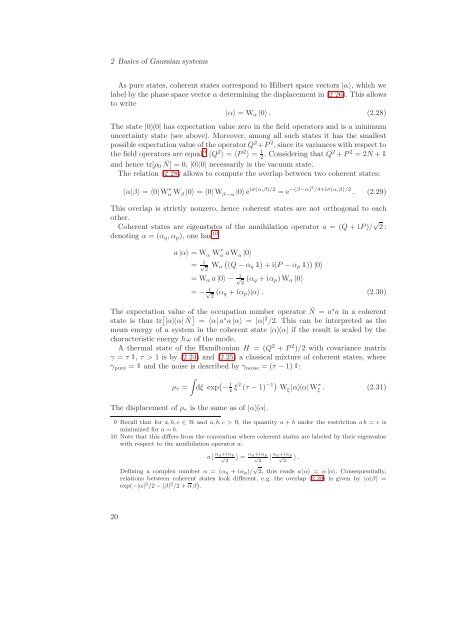Quantum Information Theory with Gaussian Systems
Quantum Information Theory with Gaussian Systems
Quantum Information Theory with Gaussian Systems
Create successful ePaper yourself
Turn your PDF publications into a flip-book with our unique Google optimized e-Paper software.
2 Basics of <strong>Gaussian</strong> systems<br />
As pure states, coherent states correspond to Hilbert space vectors |α〉, which we<br />
label by the phase space vector α determining the displacement in (2.26). This allows<br />
to write<br />
|α〉 = Wα |0〉. (2.28)<br />
The state |0〉〈0| has expectation value zero in the field operators and is a minimum<br />
uncertainty state (see above). Moreover, among all such states it has the smallest<br />
possible expectation value of the operator Q2 +P 2 , since its variances <strong>with</strong> respect to<br />
the field operators are equal, 9 〈Q2 〉 = 〈P 2 〉 = 1<br />
2 . Considering that Q2 +P 2 = 2 ˆ N +<br />
and hence tr[ρ0 ˆ N] = 0, |0〉〈0| necessarily is the vacuum state.<br />
The relation (2.28) allows to compute the overlap between two coherent states:<br />
〈α|β〉 = 〈0| W ∗ α W β |0〉 = 〈0| W β−α |0〉eiσ(α,β)/2 = e −(β−α)2 /4+iσ(α,β)/2 . (2.29)<br />
This overlap is strictly nonzero, hence coherent states are not orthogonal to each<br />
other.<br />
Coherent states are eigenstates of the annihilation operator a = (Q + iP)/ √ 2:<br />
denoting α = (αq, αp), one has 10<br />
a |α〉 = W α W ∗ α aW α |0〉<br />
= 1<br />
√ 2 Wα<br />
(Q − αq ) + i(P − αp ) |0〉<br />
= Wα a |0〉 − 1<br />
√ 2 (αq + iαp)Wα |0〉<br />
= − 1 √ 2 (αq + iαp)|α〉. (2.30)<br />
The expectation value of the occupation number operator ˆ N = a∗a in a coherent<br />
state is thus tr |α〉〈α| ˆ N = 〈α| a∗a |α〉 = |α| 2 /2. This can be interpreted as the<br />
mean energy of a system in the coherent state |α〉〈α| if the result is scaled by the<br />
characteristic energy ω of the mode.<br />
A thermal state of the Hamiltonian H = (Q2 + P 2 )/2 <strong>with</strong> covariance matrix<br />
γ = τ , τ > 1 is by (2.24) and (2.25) a classical mixture of coherent states, where<br />
γpure = and the noise is described by γnoise = (τ − 1) :<br />
<br />
ρτ = dξ exp −1 4 ξ2 (τ − 1) −1 Wξ |α〉〈α|W ∗ ξ . (2.31)<br />
The displacement of ρτ is the same as of |α〉〈α|.<br />
9 Recall that for a, b, c ∈Êand a, b, c > 0, the quantity a + b under the restriction a b = c is<br />
minimized for a = b.<br />
10 Note that this differs from the convention where coherent states are labeled by their eigenvalue<br />
<strong>with</strong> respect to the annihilation operator a:<br />
20<br />
a ˛ ˛ αq+iαp<br />
√ 2<br />
¸ = αq+iαp<br />
√ 2<br />
˛ αq+iαp ¸<br />
√ .<br />
2<br />
Defining a complex number α = (αq + iαp)/ √ 2, this reads a |α〉 = α |α〉. Consequentially,<br />
relations between coherent states look different, e.g. the overlap (2.29) is given by 〈α|β〉 =<br />
exp(−|α| 2 /2 − |β| 2 /2 + α β ´ .
















